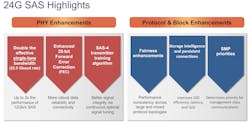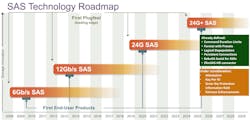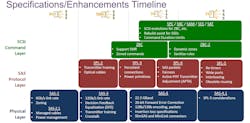Advancing Storage with 24G+ SAS
What you’ll learn:
- Features of 24G+ SAS, such as command duration limits.
- The difference between 24G+ and 24G SAS.
Serial Attached SCSI (SAS) has grown significantly over the years, providing servers and data centers with large amounts of reliable, managed storage. I recently talked with Rick Kutcipal, At-large Member with the SNIA STA Forum (formerly the SCSI Trade Association) Board of Directors, about SAS and its progression through the latest 24G+ standard (watch the video above). The new standard builds on the 24G SAS standard that arrived a few years ago (Fig. 1).
24G SAS doubled the effective bandwidth by moving to a 22.5-Gbaud rate and using a new encoding scheme. The 8b/10b used in earlier versions was replaced with a 128b/150b scheme, which delivers the 24G transfer rate. The protocol now includes a 20-bit forward-error-correction (FEC) system. This can detect all errors as well as correct up to two errors per data packet.
The transmitting training feature now operates continuously using real data. Earlier versions would train when a connection was originally started. Variations in the environment could cause the resulting configuration to be suboptimal over time. With the new approach, the transmitters and receivers are able to make adjustments over time.
Protocol enhancements included Serial Management Protocol (SMP) priorities for advanced system management as well as changes to the fairness algorithms to deliver more consistent operation across large and mixed protocol topologies. The storage intelligence and persistent connection support was designed for SSDs and to improve latency and quality-of-service (QoS) guarantees.
What’s New with 24G+?
The latest SAS roadmap (Fig. 2) adds 24G+ to the mix. These include command duration limits (CDL) to control latencies. In addition, formats with presets are designed to handle the skew reduction relative to shingled magnetic recording (SMR) and conventional magnetic recording (CMR) drives. The protocol now supports logical depopulation, which is the ability to identify bad platters and logically remove them from the dataset. There’s also an assist design to improve rebuilds with SSDs.
The persistent connection feature allows for communication between the controller and drive over a long period of time. Typically, a connection is made, data is transferred, and then the connection is closed. The new feature doesn’t replace this procedure, but it provides developers with options and tends to be applicable to superscalar applications.
The SlimSAS-HD connector (SFF-TA-1016) is a new option for cabling. It offers a high-speed, internal, unshielded connection that handles 24G SAS and 24G+ SAS devices and controllers.
The 24G+ SAS standard builds on existing 24G support (Fig. 3). Though it doesn’t deliver the same kind of performance boost as experienced with 24G, it makes management easier and provides a more robust storage environment. Features like dynamic zones and sanitized rules are part of the Zoned Block Commands-2 (ZBC-2) support. ZBC-2 targets SMR disks.
Links
About the Author
William G. Wong
Senior Content Director - Electronic Design and Microwaves & RF
I am Editor of Electronic Design focusing on embedded, software, and systems. As Senior Content Director, I also manage Microwaves & RF and I work with a great team of editors to provide engineers, programmers, developers and technical managers with interesting and useful articles and videos on a regular basis. Check out our free newsletters to see the latest content.
You can send press releases for new products for possible coverage on the website. I am also interested in receiving contributed articles for publishing on our website. Use our template and send to me along with a signed release form.
Check out my blog, AltEmbedded on Electronic Design, as well as his latest articles on this site that are listed below.
You can visit my social media via these links:
- AltEmbedded on Electronic Design
- Bill Wong on Facebook
- @AltEmbedded on Twitter
- Bill Wong on LinkedIn
I earned a Bachelor of Electrical Engineering at the Georgia Institute of Technology and a Masters in Computer Science from Rutgers University. I still do a bit of programming using everything from C and C++ to Rust and Ada/SPARK. I do a bit of PHP programming for Drupal websites. I have posted a few Drupal modules.
I still get a hand on software and electronic hardware. Some of this can be found on our Kit Close-Up video series. You can also see me on many of our TechXchange Talk videos. I am interested in a range of projects from robotics to artificial intelligence.



